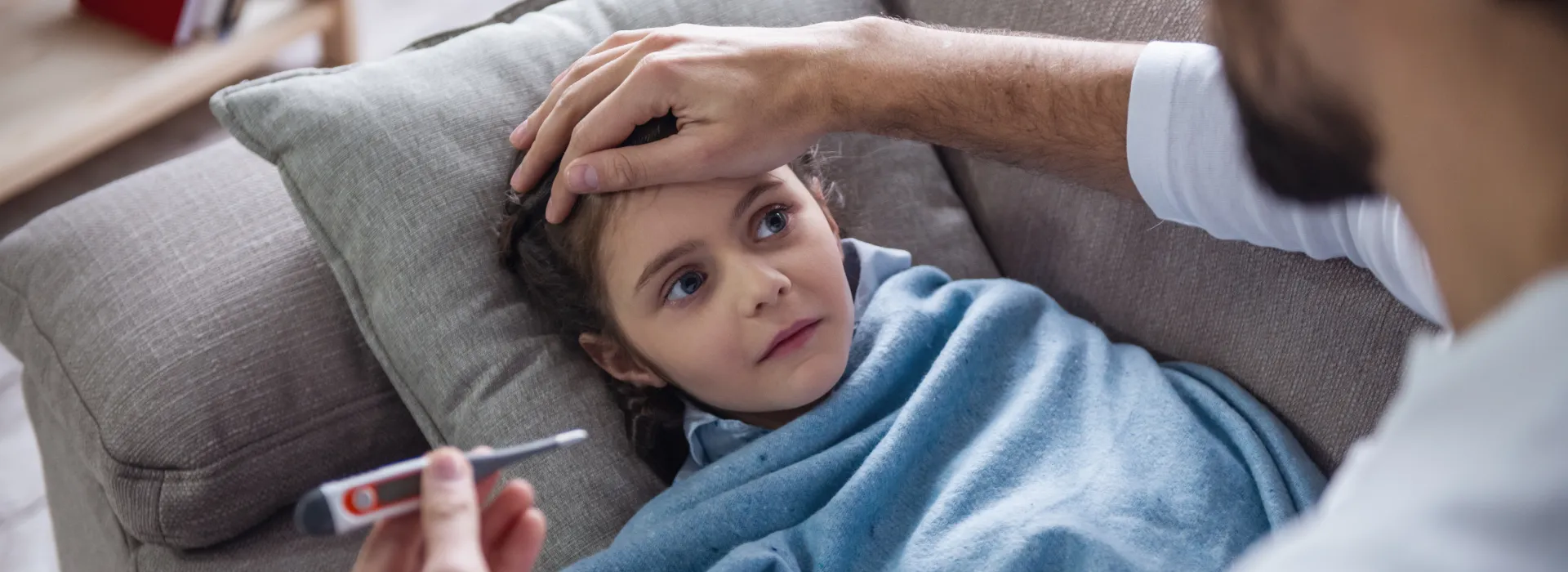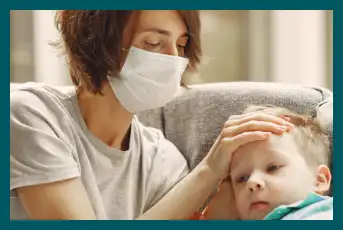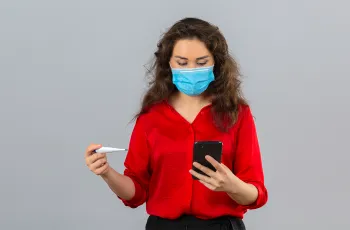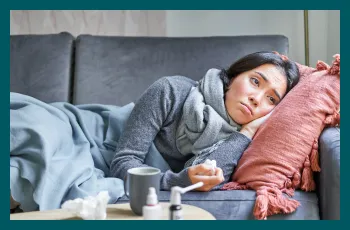How to Break a Fever in a Child: Treatment & Home Remedies
Written by Dr Nelson Lau, MBBS FRACGP, GP & Digital Health Specialist

Contents

Dealing with a fever in your child can be nerve-wracking, especially when it's your little one who feels under the weather. The good news is fevers are generally not something to panic about. They're often a sign that the body is doing its job to fight off an infection. So, let's look at how you can manage a fever at home and when you might need to seek extra help from an online doctor.
Symptoms of a fever in a child
First things first, how can you tell if your child has a fever? Well, the body’s way of signaling a fight against infection is raising its temperature. Here’s what you should keep an eye out for:- Increased body temperature: This is the classic sign. If your child’s forehead, back, or stomach feels unusually warm, they might have a fever.
- Sweating and chills: They might swing between feeling hot and cold.
- Headache: Fevers can sometimes bring on headaches.
- Fatigue: Your child may seem more tired and want to nap more often.
- Irritability: Fevers can often make kids cranky.
- Decreased appetite: Don’t be surprised if they’re not too keen on eating.
- General discomfort: Muscle aches and a general sense of being unwell are common.
When are children considered to have a fever?
To put it simply, a fever means your child's body temperature is higher than usual. Here are the thresholds:- Rectal, ear, or forehead temperature: 38°C or higher.
- Oral temperature: 37.8°C or higher.
- Armpit (axillary) temperature: 37.2°C or higher.
How to treat a fever in a child at home?
When it comes to treating a fever at home, the goal is to keep your child comfortable and hydrated. Here are some practical tips:- Hydrate, hydrate, hydrate: Keep those fluids coming. Water, clear soups, and electrolyte solutions like Hydralyte are great at helping to keep them hydrated. If they’re not up for drinking, try ice chips or popsicles. Remember to give them small frequent sips rather than large amounts at a time.
- Dress them lightly: Overdressing can trap heat. Stick to lightweight clothing and keep their room comfortably cool.
- Rest is best: Encourage your child to rest. Keeping activities low-key helps conserve their energy and aids recovery.
- Monitor their temperature: Regularly check their temperature to ensure it isn’t creeping up too high.
- Medications: If your child is uncomfortable, age-appropriate fever reducers like paracetamol or ibuprofen can help. Always follow the dosage instructions and consult a doctor if you’re unsure.
- Lukewarm baths: A lukewarm bath can help bring down the temperature. Steer clear of cold baths or ice packs as they can cause shivering, which might raise the body temperature.
What to avoid?
Certain methods can do more harm than good. Here’s what to avoid:- Cold water or ice baths: These can cause shivering, raising your child’s core body temperature.
- Alcohol rubs: These can be absorbed through the skin and aren’t safe.
- Overdressing: Keep your child lightly dressed to help regulate their body temperature.
When to consult a doctor?
Knowing when to call the doctor is crucial. You should seek medical advice if:- Your child is under 3 months old and has a fever.
- The fever lasts more than three days.
- The fever is over 40°C.
- Your child has a non-blanching rash, headache or neck stiffness.
- Your child has a seizure.
- Signs of dehydration appear, like a dry mouth, no tears when crying, or fewer wet diapers.
- Your child seems very ill, unusually drowsy, or has trouble breathing.
Can a telehealth doctor help with a fever in a child?
Telehealth services can allow you to get professional advice without leaving the comfort of your home. A telehealth doctor can assess your child’s symptoms, provide home care guidance, issue quick medical certificate for school and advise if an in-person visit is necessary.Frequently Asked Questions
Can fevers in children be prevented?
While you can’t always prevent fevers, reducing the risk is possible. Encourage regular hand washing, keep vaccinations up to date, and avoid contact with sick individuals.How to take a temperature in a child older than 6 months?
For kids over 6 months, a digital thermometer can be used rectally, orally, or in the armpit. Ear thermometers work too, just make sure they’re positioned correctly.How to take a temperature in a child older than 4 years?
Oral thermometers are usually accurate for older children. Ensure they haven’t had anything hot or cold to eat or drink within 15 minutes of taking their temperature.At what temperature should a child go to the hospital in Australia?
In Australia, seek hospital care if your child's temperature is over 40°C, or if they have symptoms like difficulty breathing, persistent vomiting, a headache or a rash.What to do when a fever won’t settle in kids?
If a fever persists despite home treatments, it’s essential to consult a doctor. Persistent fevers can signal an underlying condition that needs medical attention.How to bring down a fever in a child while sleeping?
Ensure they’re lightly dressed and in a cool room. Offer fluids and use fever-reducing medications if recommended by your doctor. Keep an eye on their temperature through the night.Can a cold towel help with a fever?
Yes, placing a cool, damp cloth on your child’s forehead can provide comfort and help reduce their temperature.Why do fevers spike at night?
Fevers often seem worse at night due to our natural circadian rhythms. Our body temperatures tend to be slightly higher in the evening and overnight hours, which can cause a fever to spike during this time. Managing a fever in a child can be challenging, but with the right approach, you can help your little one feel better in no time. Keep them hydrated, ensure they rest, and monitor their temperature. Knowing when to seek medical advice is key, and telehealth services can offer a convenient way to get help when needed. Stay proactive about your child’s health, and don’t hesitate to consult a healthcare professional if you’re ever unsure about any symptoms or treatments.Feeling sick and unsure why? Speak with a GP online in 15 minutes.
See a Doctor now
Available 24/7, across Australia.
Feeling sick and unsure why? Speak with a GP online in 15 minutes.
See a Doctor now
Available 24/7, across Australia.
What we treat
- Cough
- Nausea & vomiting
- Fever
- Hayfever
- Fatigue
- Sore throat
- Acne
- Hair loss
- Gout
- Eczema
- Rosacea
- Sunburn
- UTI
- Erectile dysfunction
- Contraception
- Morning sickness
- Morning after pill
- Prostate health
- Anxiety
- Depression
- Stress
- Grief & loss
- Antidepressants
- Premature ejaculation
- Asthma
- Blood pressure
- Blood thinners
- Diabetes
- Cholesterol
- Migraines & headaches
- Allergies
- Body ache
- Heartburn & reflux
- Sleep disorder
- Pain relief
- Gastro
Related Articles
Disclaimer
This blog is for general informational purposes only and does not indicate that Hola Health provides all treatments or preventive measures mentioned. It is not intended to be a substitute for professional medical advice. Always seek the guidance of your doctor or other qualified health professional with any questions you may have regarding your health or a medical condition. For emergencies please immediately contact 000. Any medical topics discussed are intended to educate, not to imply availability through Hola Health.
 Facebook
Facebook  X
X  Copy Link
Copy Link



